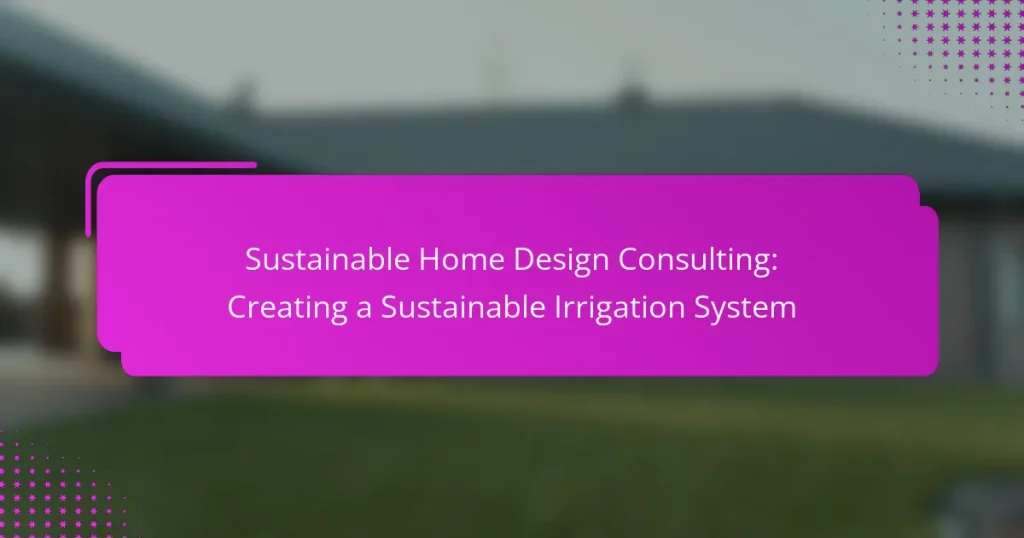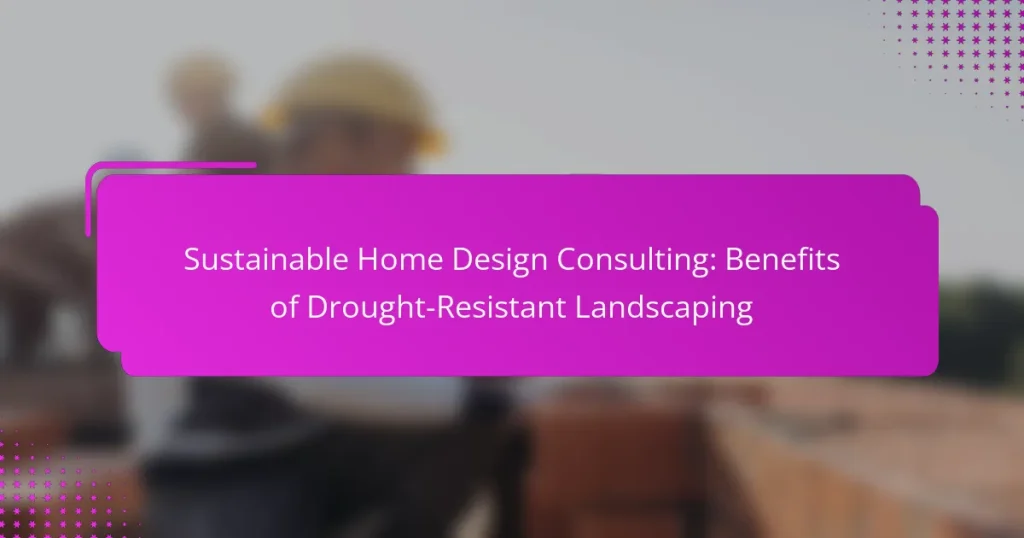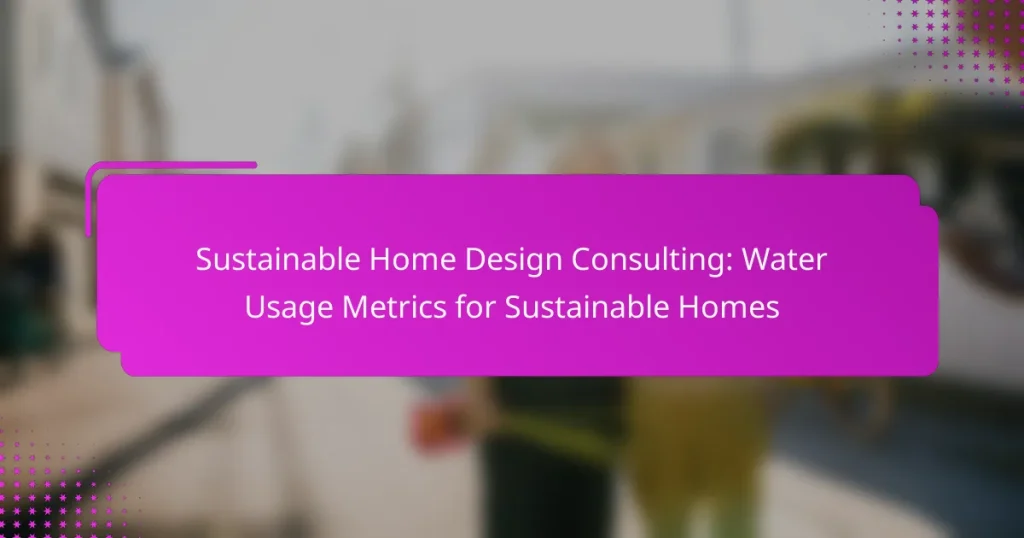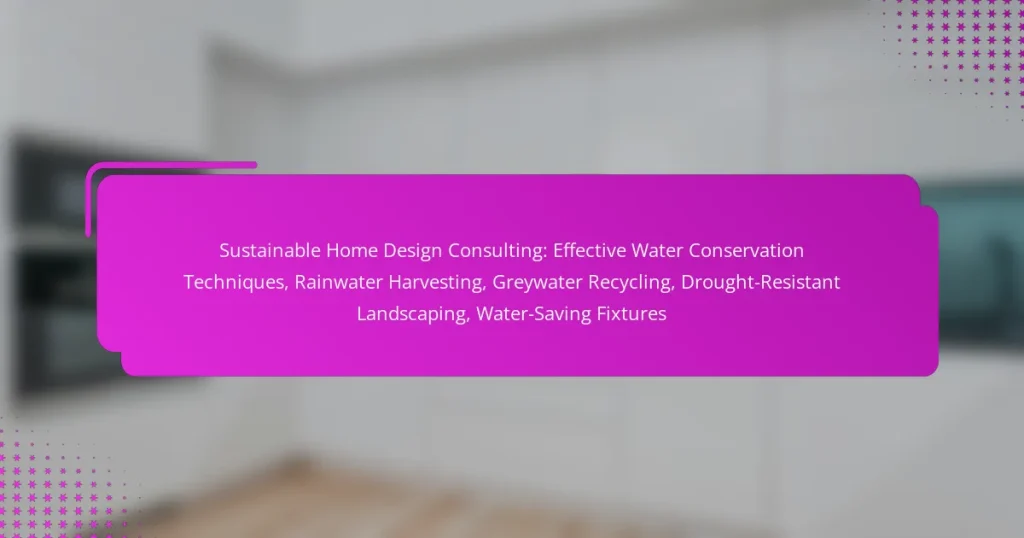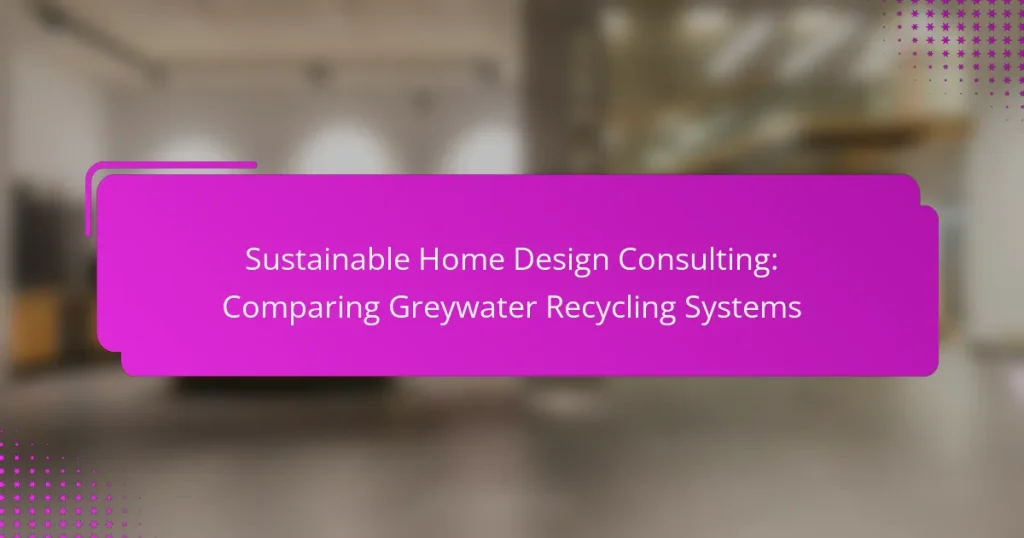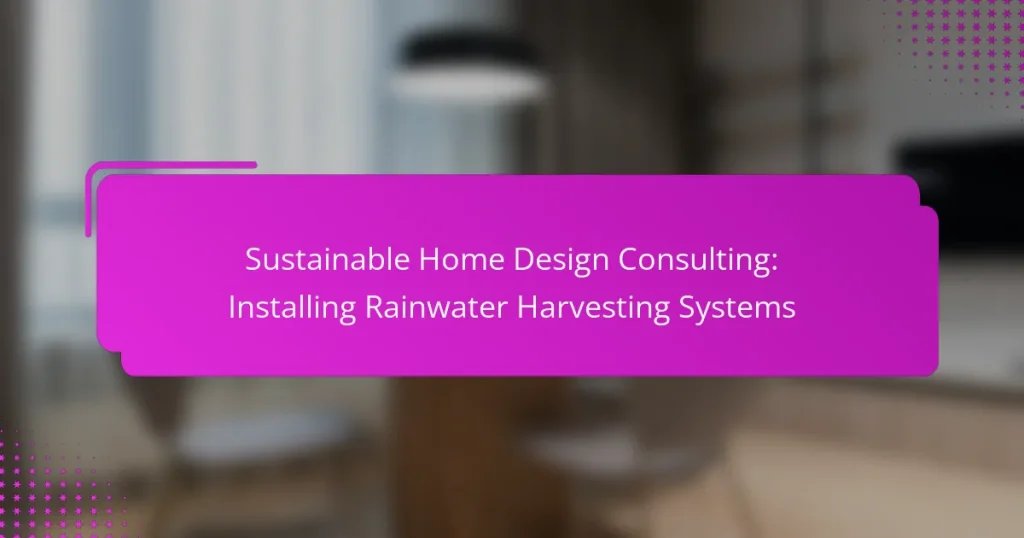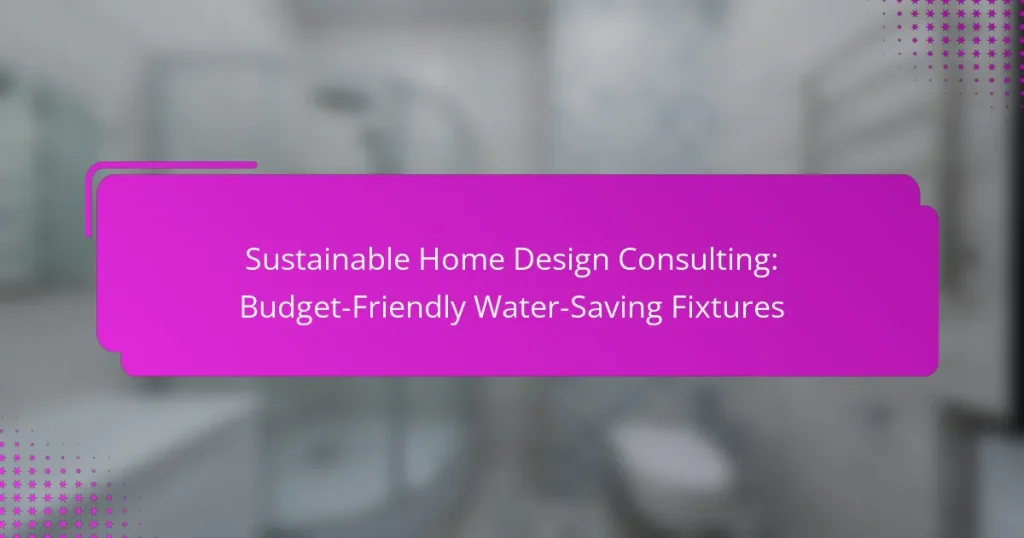Sustainable home design consulting focuses on innovative water conservation techniques that minimize usage without compromising comfort or style. By incorporating practices such as rainwater harvesting and greywater recycling, homeowners can significantly lower their utility bills and contribute to environmental sustainability.
Sustainable Home Design Consulting: Benefits of Drought-Resistant Landscaping
Sustainable Home Design Consulting: Water Usage Metrics for Sustainable Homes
Sustainable Home Design Consulting: Effective Water Conservation Techniques, Rainwater Harvesting, Greywater Recycling, Drought-Resistant Landscaping, Water-Saving Fixtures
Sustainable Home Design Consulting: Comparing Greywater Recycling Systems
Sustainable Home Design Consulting: Installing Rainwater Harvesting Systems
Sustainable Home Design Consulting: Budget-Friendly Water-Saving Fixtures
What are effective water conservation techniques for sustainable home design?
Effective water conservation techniques for sustainable home design include systems and practices that significantly reduce water usage while maintaining functionality and aesthetics. Implementing these techniques can lead to lower utility bills and a reduced environmental footprint.
Rainwater harvesting systems
Rainwater harvesting systems collect and store rainwater from roofs for later use, such as irrigation or toilet flushing. Homeowners can install cisterns or barrels to capture runoff, which can save thousands of liters of water annually, depending on rainfall and collection capacity.
When designing a rainwater system, consider local regulations regarding water use and storage. It’s also important to ensure proper filtration and treatment to make the water safe for its intended use.
Greywater recycling systems
Greywater recycling systems reuse water from sinks, showers, and washing machines for irrigation or toilet flushing. This can reduce overall household water consumption by up to 50%, making it a practical choice for sustainable homes.
Installing a greywater system requires careful planning to ensure compliance with local codes and to prevent contamination. Homeowners should consider using biodegradable soaps and detergents to maintain water quality.
Low-flow fixtures
Low-flow fixtures, including faucets, showerheads, and toilets, are designed to use significantly less water than standard models. For example, low-flow toilets typically use about 1.28 gallons per flush compared to older models that may use 3.5 gallons or more.
Upgrading to low-flow fixtures is a straightforward way to reduce water usage without sacrificing performance. Look for fixtures with the WaterSense label, which indicates they meet EPA efficiency standards.
Permeable paving solutions
Permeable paving solutions allow rainwater to infiltrate the ground rather than running off into storm drains. This can help recharge groundwater supplies and reduce the risk of flooding. Options include permeable concrete, porous asphalt, and interlocking pavers.
When selecting permeable materials, consider local soil conditions and drainage needs. Regular maintenance, such as cleaning to prevent clogging, is essential to ensure effectiveness.
Native landscaping
Native landscaping involves using plants that are indigenous to the local area, which typically require less water and maintenance. These plants are adapted to local climate conditions and can thrive with minimal irrigation once established.
Incorporating native plants into your landscape design can significantly reduce water consumption and promote biodiversity. Consider creating a rain garden or using xeriscaping principles to further enhance water conservation efforts.
How can I implement rainwater harvesting in my home?
Implementing rainwater harvesting in your home involves collecting and storing rainwater for various uses, primarily irrigation. This sustainable practice can reduce water bills and lessen the demand on municipal water systems.
Install a rain barrel
Installing a rain barrel is one of the simplest ways to start harvesting rainwater. Choose a barrel with a capacity of at least 50 to 100 gallons, and position it under a downspout to collect runoff from your roof.
Make sure the barrel has a lid to prevent mosquito breeding and debris contamination. Many local regulations may require specific features, such as a first-flush diverter, to ensure clean water collection.
Connect to downspouts
Connecting your rain barrel to downspouts is crucial for efficient water collection. Use a diverter kit to redirect water from the downspout into the barrel while allowing overflow to continue down the original path.
Ensure that the connection is secure and that the downspout is properly aligned to maximize water flow. Regularly check for clogs or blockages to maintain optimal performance.
Use for irrigation
Once your rainwater is collected, it can be used for irrigation, which is one of the most effective applications. Use a soaker hose or drip irrigation system to distribute water directly to plant roots, minimizing evaporation.
Consider using a pump if you need to move water to elevated garden beds or larger areas. Always check local regulations regarding the use of harvested rainwater, as some areas have specific guidelines for irrigation practices.
What are the benefits of greywater recycling?
Greywater recycling offers significant advantages, including reduced water consumption and lower utility costs. By repurposing water from sinks, showers, and laundry, homeowners can conserve resources while maintaining a sustainable lifestyle.
Reduces water usage
Implementing greywater recycling systems can dramatically decrease overall water usage in a home. By reusing water for irrigation or toilet flushing, households can cut down on their fresh water demand by up to 50%. This not only conserves a precious resource but also promotes responsible water management.
When considering a greywater system, it’s essential to evaluate the types of greywater generated in your home. For instance, water from laundry may contain detergents that are not suitable for all plants, so selecting the right applications is crucial for effective reuse.
Decreases utility bills
By recycling greywater, homeowners can see a noticeable reduction in their water bills. The savings can vary, but many report cuts of 20-50% in their monthly water expenses, depending on the system’s efficiency and household water usage patterns.
To maximize savings, consider installing a greywater system that complies with local regulations, which may offer incentives or rebates. Regular maintenance of the system is also important to ensure it operates efficiently and continues to provide cost benefits over time.
What low-flow fixtures are recommended for homes?
Low-flow fixtures are essential for conserving water in homes, significantly reducing water usage without sacrificing performance. Recommended fixtures include low-flow showerheads and water-efficient toilets, which can help homeowners save on water bills and contribute to environmental sustainability.
Low-flow showerheads
Low-flow showerheads typically use 1.5 to 2.0 gallons per minute (GPM), compared to standard models that can use over 2.5 GPM. These fixtures maintain water pressure while reducing overall consumption, making them an effective choice for water conservation. Look for models that are WaterSense certified to ensure efficiency and performance.
When selecting a low-flow showerhead, consider the spray pattern and adjustability to enhance your shower experience. Some models offer multiple settings, allowing you to customize your water flow while still conserving water. Regular maintenance, such as descaling, can also help maintain optimal performance.
Water-efficient toilets
Water-efficient toilets use 1.28 gallons per flush (GPF) or less, compared to older models that may use 3.5 to 7 GPF. Dual-flush toilets are another option, allowing users to choose between a lower flush for liquid waste and a higher flush for solid waste, further conserving water. Choosing a toilet with the EPA’s WaterSense label can ensure you are selecting a high-efficiency model.
When upgrading to a water-efficient toilet, consider the flushing mechanism and bowl design, as these can impact performance. It’s also essential to check for leaks and ensure proper installation to maximize water savings. Regular inspections can help maintain efficiency and prevent unnecessary water waste.
What are the prerequisites for sustainable home design consulting?
Prerequisites for sustainable home design consulting include a solid understanding of environmental principles, local building codes, and water conservation techniques. Professionals must be equipped with knowledge of site-specific factors and regulations that influence sustainable practices.
Site assessment
A thorough site assessment is crucial for sustainable home design. This process involves evaluating the land’s topography, soil quality, and existing vegetation to determine how these factors affect water drainage and conservation. Understanding the site’s natural features helps in planning effective water management systems.
During the assessment, consider aspects such as sun exposure, wind patterns, and proximity to water sources. These elements can guide decisions on landscaping and the placement of rainwater harvesting systems. For instance, sloped sites may require different drainage solutions compared to flat areas.
Building regulations
Building regulations play a vital role in sustainable home design, particularly regarding water conservation. Familiarity with local codes ensures compliance with standards that promote efficient water use, such as restrictions on irrigation systems and requirements for greywater recycling. In the U.S., for example, many states have adopted the International Green Construction Code (IgCC).
Consultants should also be aware of incentives or rebates offered by local governments for implementing water-saving technologies. These can significantly offset initial costs. Always verify the latest regulations, as they can change frequently and may vary widely between municipalities.
